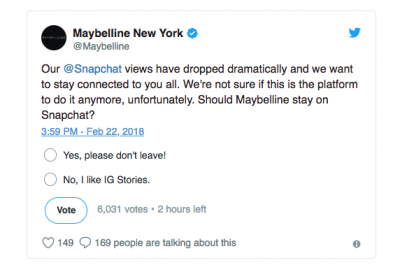3 ways cosmetics brands can win at social media engagement and monitoring
Maybelline’s since deleted tweet calling followers to vote on whether to stay active on Snapchat in view of declining audience reach, called to mind a common dilemma amongst regional brands.

In a time of post-display algorithms and content clutter, marketers face increasing challenges in maximising the ROI of social activities, as well as understanding consumer preferences in a fast-changing industry.
With an immense volume of content being posted online around makeup brands every day, how can cosmetics marketers be strategic in monitoring and engaging consumers online?
To identify key trends in consumer behavior on social media, Digimind analyzed online discussions around 22 international cosmetics brands in Australia, Hong Kong, Indonesia, Malaysia, Singapore, and The Philippines from 13 January to 6 March 2018, in English, Mandarin, Malay, and Tagalog.
Facebook vs Twitter vs Instagram: How are Cosmetics Customers Interacting with Brands?
Looking at brand-related posts by customers on social media, 56.7% of discussions were on Instagram, making it a treasure trove of user generated content (UGC), where makeup fans shared various looks, makeovers, and product hauls. Posts on the photo and video sharing platform also tended to tag brands used, as well as include official hashtags in order to get more views.
A wide variety of discussions took place on Twitter, where 23.1% of consumer discussions took place. Customers expressed intent or excitement over buying new products, or exchanged reviews and opinions. Unlike Instagram, Internauts did not tag brands studied or include hashtags, showing a preference to express themselves or share their shopping hauls with their personal network.
Facebook, which accounted for 17.6% of consumer discussions and 59.6% of brand audiences, comprised mostly beauty retailers like Sephora, who promoted brands and products available at their physical and ecommerce stores.
“One Size Fits All”, No More
The varying trends in consumer discussions on Instagram and Twitter shows how differently cosmetics customers interact with brands, or share their experiences and opinions on each platform.
Marketers must thus adapt their content and engagement strategies, by sharing the right content at the right time and the right place, so as to deliver experiences that are relevant, engaging, and value adding for customers on each platform.
Inspire and Engage on Social
By gathering insights on consumer discussions and behaviors, marketers can detect top trending attributes of their respective markets, and adapt content engagement activities to these trends.
With 80% of user generated content (UGC) around festive holidays and weddings, cosmetics brands can take product showcases and launches one step further, by creating tutorials, style guides, or inspired looks around these occasions, and inviting customers to post their own creations using a branded hashtag.
Establish an engagement plan for posts on Instagram, to engage with brand advocates and nurture brand advocacy and loyalty:
- Identify potential influencers to collaborate with through user generated content (UGC)
- Comment or re-share inspirational posts featuring your brand
- Identify brand ambassadors who frequently tag your brand in their posts and partner with them for promotional activities
- Focus on genuinely engaging with customers who post brand related content instead of using a third party automation tool; authenticity plays a critical role in showcasing a brand’s sincerity, which in turn increases customer loyalty
Listen, then React
In an industry defined by competitiveness and flux, it is crucial for cosmetics brands to keep a pulse on consumer preferences, shopping habits, and beauty fads, so they can meet these demands and position products in a relatable and engaging way on social media.
Monitoring discussions can give precious insight into:
- What type of products encourage hype and are preferred by customers
- What motivates customers to buy
Marketers can the leverage these insights to create and position products strategically and to develop content strategies.
Bonus: To understand how these trends evolve in real time, establish a strategy to track and aggregate insights collected from online discussions. See how Digimind Social can help you better understand and target customers on social!
What is Social Media Monitoring?
Written by Melissa Chue
Melissa is a digital advocate who loves diving into the latest trends in digital and social media. Since joining Digimind’s marketing team in 2015, she has written studies for over 15 industries in Asia Pacific. When she is not telling stories about data, Melissa can be found exploring her favourite cafes and hangouts on Instagram @chuepachups.
